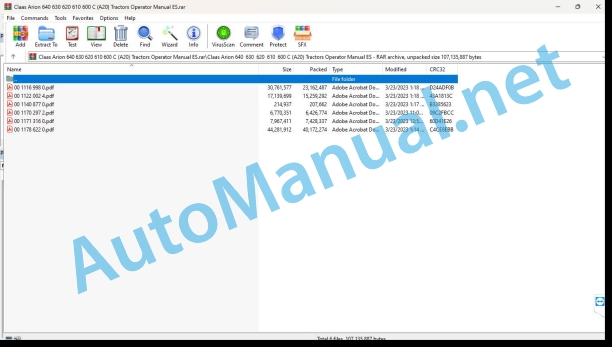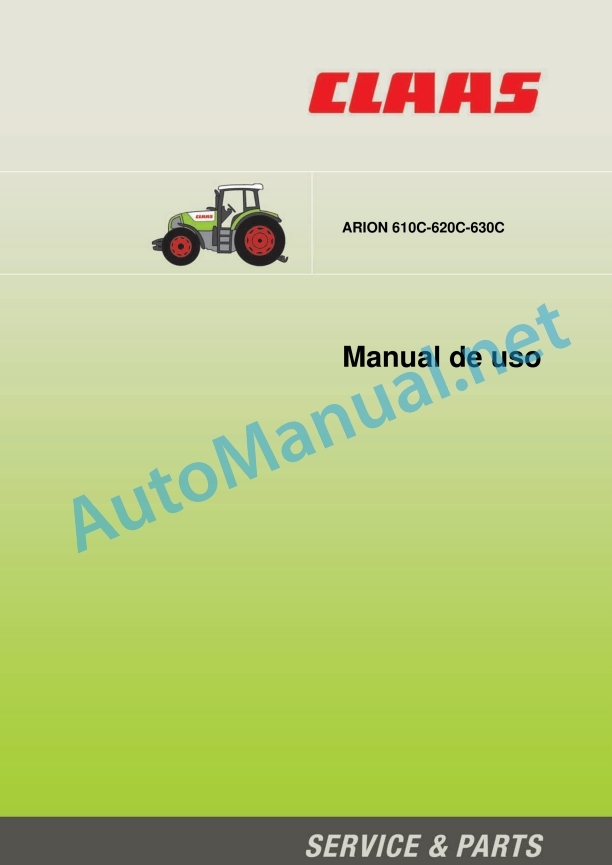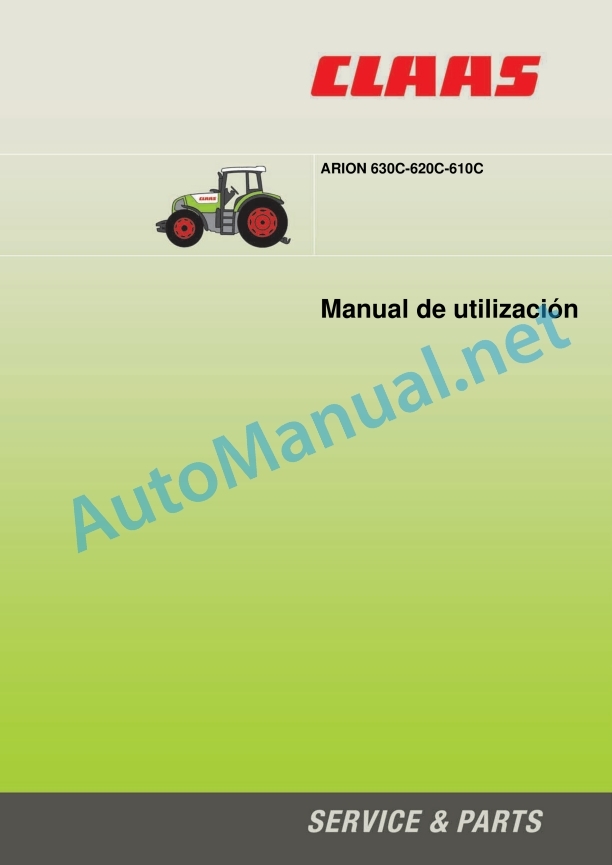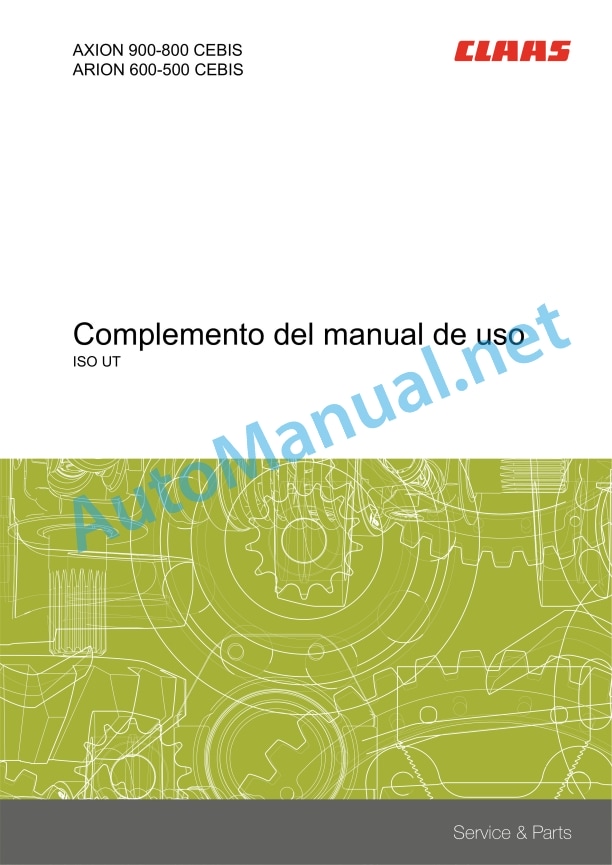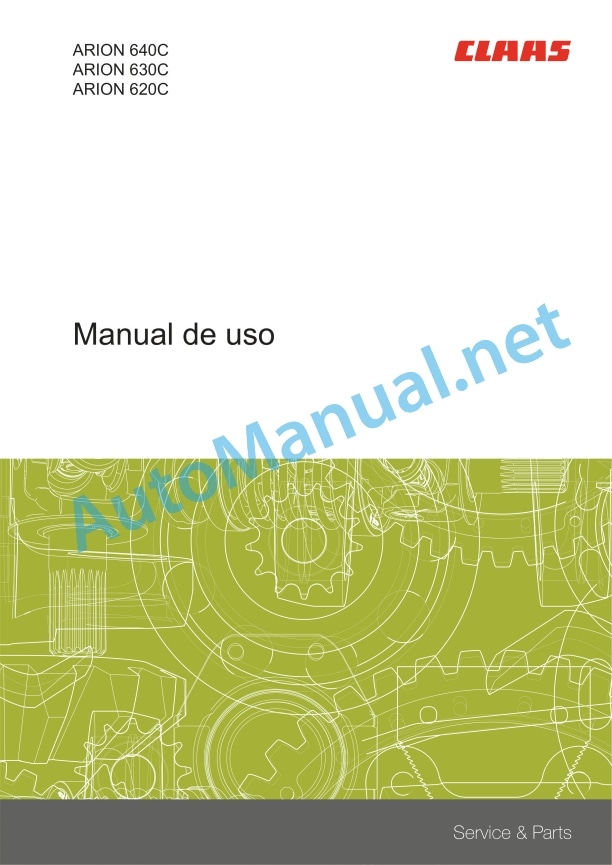Claas Arion 640 630 620 610 600 C (A20) Tractors Operator Manual ES
$50.00
- Model: Arion 640 630 620 610 600 C (A20) Tractors
- Type Of Manual: Operator Manual
- Language: ES
- Format: PDF(s)
- Size: 88.4 MB
File List:
00 1116 998 0.pdf
00 1122 002 4.pdf
00 1140 877 0.pdf
00 1170 297 2.pdf
00 1171 316 0.pdf
00 1178 622 0.pdf
00 1116 998 0.pdf:
recommendations
For your security
Use according to the purpose
Description
Description: Chapter symbols
A – Identification – Homologation – Safety
tractor plate
Drive plate
Homologation
Security
Security instructions
Safety stickers with warning pictograms
B – Driving position
Driving and working environment
Controls and instruments (driving position)
Controls and instruments (instrument panel)
Accommodations and accessories
Lighting, signaling and security
Description
Driving lights and acoustic warning
Work lights and rotating headlight
Roof light
General key contactor
Description
Utilization
steering wheel
Adjustment
Dashboard
Description
Functioning
Utilization
Calibration
Natural aeration and crystals
Utilization
Heating – ventilation – manual air conditioning
Description
Utilization
cab suspension
Adjustment
C – Electricity
Trailer/tool lighting socket
Description
Power socket electrical box
Description
Predisposition to install a control box in the cabin
Fixing the box support
Cable routing
Description
battery switch
Description
Fuses and relays
recommendations
Preheating fuse/relay
Main fuse box
Upper cabin fuse box
Description
Affectation of the relays
Fuse assignment
D – Engine
Characteristics
Visualizers
Description
Security
Safety: Mechanical protection
engine control
Engine start
throttle controls
Engine stop
recommendations
E – Transmission
Transmission characteristics
Feed speed
rear axle
power take-offs
Visualizers
Dashboard
Security
Neutral inverter
Neutral transmission
Mechanical protection
Set otion
Manual gear operation
Automatic gear change
Relationship management
Reduced range
rear axle
Locking differentials
Tractor braking
Trailer braking
power take off
Permanent job
Obligations
Obligations
F – Front axle
Front bridge
Characteristics
Mechanical protection
Functioning
Front axle gear
Functioning
Automatic mode
Permanent mode
G – Hydraulic system – rear lift and hitch
Characteristics
Hydraulic
Elevation
Hydraulic
Auxiliary distributors
Elevation
Controls
Security
Lift start-up
Mode selection
Position control
Effort control
High stop
Descent speed
Transport shock absorber
External controls
Upper connecting rod
Stabilizers
Automatic hooks
hitch bolts
Pickup hitch
J – Wheels and tires
recommendations
inflation pressure
Wheel pairing
Features: commissioning
front tracks
rear tracks
Tire combinations
Particular cases
Tools that work at great depth
K – Dimensions, weights, capacities and ballast
Dimensions and weights
Description
Capabilities
Description
Ballasted
Description
L – Maintenance
Generalities
recommendations
Periodicity
Summary table
Operations
Bleeding air from the injection circuit
Description
Logbook of maintenance operations
recommendations
M – Mandatory guarantee operations
Mandatory operations carried out within the framework of the contractual guarantee
Inspection before delivery – Delivery to customer
Maintenance operations to be carried out
Mandatory visits
00 1122 002 4.pdf:
. Information about this user manual
. Validity of instructions
. Chapter symbols
A – Identification – Homologation – Safety
1. Tractor signal plate
2. Tractor power label
3. Engine signal plate
4. Cabin nameplate
5. European regulations
6. Security
6.1. Security instructions
6.1.1. Use according to the purpose
6.1.2. Use not in accordance with assignment
6.1.3. Precautions to be taken before starting up
6.1.4. Tractor status
6.1.5. Adjustment or maintenance work – repairs
6.1.5.1. General rule
6.1.5.2. Placement on lifting arms
6.1.5.3. Electricity
6.1.5.4. Fuel
6.1.5.5. Coolant liquid
6.1.6. Circulation – Transport
6.1.7. Tractor use
6.1.7.1. General rule
6.1.7.2. Tractor wheelbase
6.1.7.3. Tool attachment
6.1.7.4. Driving
6.1.7.5. Permanent jobs
6.1.7.6. Work with tools powered by the power take-off
6.1.7.7. Severe applications
6.1.8. Toxic products
6.1.9. Air-conditioning
6.1.10. Cabin
6.1.11. passenger seat
6.1.12. Respect for the environment
6.1.13. Using a front loader
6.1.14. Forestry applications
6.2. Safety stickers with warning pictograms
6.2.1. recommendations
6.2.2. Putting the gearbox in neutral
6.2.3. Front lift
6.2.4. Front tow hook
6.2.5. User manual
6.2.6. passenger seat
6.2.7. Speed limit and child under 13 years old
6.2.8. Air conditioning
6.2.9. PTO 1,000 1/min
6.2.10. hydraulic hoses
6.2.11. External controls
6.2.12. start
6.2.13. Battery
6.2.14. Radar
6.2.15. PTO protection
6.2.16. High pressure cleaner
6.2.17. Accumulators
6.2.18. FOPS Roof
6.2.19. Wheel nuts
B – Driving position
1. Driving and working environment
1.1. Controls and instruments (cockpit)
1.2. Controls and instruments (dashboard)
1.3. Accommodations and accessories
2. Lighting, signage and security
2.1. Description
2.2. Low beam/high beam and klaxon
23. Work lights and rotating headlight
2.4. Roof light
2.5. Mirrors
2.6. Signal triangle
3. Start contactor
4. Seats
4.1. driver’s seat
4.2. passenger seat
5. steering wheel
6. Dashboard
6.1. Diption
Functioning
6.3. Utilization
6.4. Calibration
7. Openers and glass
8. Viewer
9. Heating – ventilation – manual air conditioning
9.1. Description
9.2. Utilization
10. Cabin suspension
C – ELECTRICITY
1. Features
2. Trailer/tool lighting socket
3. Power socket electrical box
4. Predisposition for the installation of a control box in the cabin
4.1. Fixing the box support
4.2. Cable routing
5. Battery
5.1. battery tray
5.2. battery switch
6. Fuses and relays
6.1. recommendations
6.2. Preheating fuse/relay
6.3. Main fuse box
6.4. Upper cabin fuse box
D – Engine
1. Features
2. Visualizers
2.1. Dashboard
3. Security
3.1. Functioning
3.2. Dashboard
3.3. recommendations
4. Engine hood
4.1. Monobloc hood
4.2. Side hoods
5. Engine control
5.1. Engine start
5.1.1. Preliminary operations
5.1.2. Start up
5.1.3. Coolant heater
5.2. throttle controls
5.2.1. Functioning
5.2.2. Accelerapedal
5.2.3. manual throttle
5.3. Engine stop
6.1. recommendations
6.2. Bleeding air from the injection circuit
E – Transmission
1. Features
2. Forward speeds
3. Indication
4. Security
4.1. Neutral inverter
4.1.1. Utilization
4.1.2. Functioning
4.2. Neutral transmission
4.2.1. Utilization
4.2.2. Functioning
4.3. Protection of mechanical organs
5. Setting in motion
5.1. Clutch
5.1.1. recommendations
5.1.2. Clutch pedal
5.1.3. reverse lever
5.2. Selection of feed direction
6. Manual gear operation
6.1. Work mode
6.2. Transport mode
6.3. Starting ratio
6.3.1. Functioning
6.3.2. Adjustment
7. Automatic gear change
7.1. Automatic speed adaptation (Speed matching)
7.1.1. Utilization
7.1.2. Functioning
8. Relationship Management
9. Super-slow range
9.1. Utilization
9.unctioning
rear a 1. Features
2. Indication
3. Protection of mechanical organs
3.1. Functioning
4. Locking differentials
4.1. recommendations
4.2. GENERALITIES
4.3. Locking differentials
4.3.1. Utilization
4.3.2. Functioning
5. Brakes
5.1. Service brakes
5.2. Parking brake (auxiliary and parking brake)
5.2.1. Obligations
5.2.2. Hand brake
6. Trailer braking
6.1. Hydraulic brake
6.2. pneumatic brake
F – Front axle
1. Features
2. Protection of mechanical organs
3. Front axle gear
3.1. Functioning
3.2. Automatic mode
3.2.1. Utilization
3.2.2. Functioning
3.3. Permanent mode
3.3.1. Utilization
3.3.2. Functioning
G – Rear equipment
Hydraulic
1. Features
2. Auxiliary distributors
2.1. Association of rear controls/pressure taps
2.2. pressure taps
2.2.1. recommendations
2.2.2. Utilization
2.2.3. Free return to the warehouse
2.2.4. Oil recovery button
23. Controls
2.4. Control levers
2.5. Hydraulic flow accumulation switch
2.6. Flow regulator
2.7. Double acting/single acting conversion
3. Permanent job
rear lift
1. Features
2. Controls
3. Security
3.1. Protection of mechanical organs
3.2. safety pilot
3.3. Transportation security
4. Lift start-up
5. Mode selection
6. Position control
7. Effort control
8. High cap
9. Download speed
10. Transport shock absorber
11. External controls
11.1. Utilization
11.2. Functioning
rear power take off
1. Features
2. Recommendations
3. Usage
4. Indication
5. PTO speed selection
6. Operation
7. PTO ferrule
8. Tool attachment on the power take-off
9. Permanent job
rear hitch
1. Features
2. Recommendations
3. Fixing mechanisms
4. Upper connecting rod
5. Automatic hooks
6. Stabilizers
6.1. Utilization
6.2. Mechanical stabilizers
7. Hitch Bolts
8. Swing bar
9. Pickup hitch
H – Front equipment
Hydraulic
1. Features
2. Association of front pressure controls/sockets
3. Pressure taps
3.1. recommendations
3.2. UTILIZATION
3.3. Free return to the warehouse
3.4. Oil recovery button
4. Hydraulic flow accumulation switch
Front lift
1. Features
2. Controls
3. Security
3.1. Private lockers
4. Preliminary operations
6. 3-point hitch
6.1. lower cranks
6.2. Upper connecting rod
6.3. Hitching and unhitching the implement
front power take off
1. Features
2. Recommendations
3. Front PTO interlock
4. Front PTO stop
5. Adjustment
Front loader
1. Assembly of an adaptation structure for a front loader
J – Wheels and tires
1. Tires
1.1. recommendations
1.2. inflation pressure
1.2.1. Characteristics
1.2.2. recommendations
1.3. Load index
1.4. speed code
2. Paths
2.1. Commissioning
2.2. front tracks
2.2.1. Front bridge
2.2.2. Front Track Tables
2.2.3. Front axle swing stops
23. rear tracks
2.3.1. rear axle
2.3.2. Rear track boards
2.4. Tire combinations
3. Wheels
K – Features
1. Dimensions
2. Weight
3. Loading capacities
4. Maximum permissible towable masses
5. Capacities
6. Weighted
6.1. Ballasts available
6.2. Tractor balancing
7. Cabin comfort
7.1. Sound level
7.2. vibration level
L – Maintenance
1. Recommendations
2. Trailer
3. Transportation
4. Using a jack
5. Changing a wheel
6. Tractor loading and stowage
7. Parking
8. Disablement and destruction
9. Periodicities
9.1. Summary table
9.2. Operations
9.2.1. Operation #1
9.2.2. Operation #2
9.2.3. Operation #3
9.2.4. Operation #4
9.2.5. Operation #5
9.2.6. Operation #6
9.2.7. Operation #7
9.2.8. Operation #8
9.2.9. Operation #9
9.2.10. Operation #10
9.2.11. Operation #11
9.2.12. Operation #12
9.2.13. Operation #13
9.2.14. Operation #14
9.2.15. Operation #15
9.2.16. Operation #16
9.2.17. Operation #17
9.2.18. Operation #18
9.2.19. Operation #19
9.2.20. Operation #20
9.2.21. Operation #21
9.2.22. Operation #22
9.2.23. Operation #23
9.2.24. Operation #24
9.2.25. Operation #25
9.2.26. Operation #26
9.2.27. Operation #27
9.2.28. Operation #28
9.2.29. Operation #29
9.2.30. Operation #30
9.2.31. Operation #31
9.2.32. Operation #32
9.2.33. Operation #33
9.2.34. Operation #34
9.2.35. Operation #35
9.2.36. Operation #36
9.2.37. Operation #37
9.2.38. Operation #38
9.2.39. Operation #39
9.2.40. Operation #40
9.2.41. Operation #41
9.2.42. Operation #42
9.2.43. Operation #43
9.2.44. Operation #44
9.2.45. Operation #45
9.2.46. Operation #46
9.2.47. Operation #47
9.2.48. Operation #48
9.2.49. Operation #49
9.2.50. Operation #50
9.2.51. Operation #51
9.2.52. Operation #52
9.2.53. Operation #53
9.2.54. Operation #54
9.2.55. Operation #55
9.2.56. Operation #56
9.2.57. Operation #57
9.2.58. Operation #58
9.2.59. Operation #59
9.2.60. Operation No. 60
10. Bleeding the air from the injection circuit
11. Maintenance operations logbook
M – Mandatory warranty operations
1. MANDATORY OPERATIONS CARRIED OUT WITHIN THE FRAMEWORK OF THE CONTRACTUAL WARRANTY
1.1. Inspection before delivery
1.2. Customer delivery
1.3. MAINTENANCE OPERATIONS TO BE CARRIED OUT
1.4. Mandatory visits
1.4.1. Mandatory inspection after the first 100 hours
1.4.2. Mandatory inspection after the first 500 hours
Alphabetical index
00 1170 297 2.pdf:
AXION 900-800ARION 600-500-400
1. Introduction
1.1 Information regarding the instruction manual
1.1.1 Application of this manual
2 Prepare the tractor
2.1 Assembly and body parts
2.1.1 Legal equipment according to regulation (EU) 167/2013
Tractor with a length greater than 4.6 m: AXION 900, AXION 800, ARION 600 and ARION 500
Tractor with a total width greater than 2.55 m: AXION 900, AXION 800, ARION 600 and ARION 500
CIS tractor with a total width greater than 2.82 m and CEBIS tractor with a total width greater than 2.75 m: AXION 900, AXION 800, ARION 600 and 500
Tractor with a total width greater than 2.55 m: ARION 400
Tractor with a total width less than 2.55 m: ARION 600, 500 and 400
CIS tractor with an overall width of less than 2.82 m: AXION 900, AXION 800, ARION 600 and 500
CEBIS tractor with a total width of less than 2.75 m: AXION 900, AXION 800, ARION 600 and 500
Extension of signage posters
00 1171 316 0.pdf:
AXION 900-800 CEBISARION 600-500 CEBIS
1. Introduction
1.1 Information regarding the instruction manual
1.1.1 Application of this manual
2 Control and display instruments
2.1 CEBIS
2.1.1 Work phases
road mode
Field mode
ISO Terminal Mode
2.1.2 Work phases
ISO Terminal Mode
2.1.3
2.1.4 Menu
00 1178 622 0.pdf:
User manual
1. Introduction
1.1 Information regarding the instruction manual
1.1.1 Use the user manual
Important information about this user manual
Structuring according to tractor subassemblies
Search and find
Direction signs
Specific terminology
Optional equipment and supplementary equipment
1.1.2 Symbols and instructions
Texts and illustrations
Indication of dangers and warnings
1.1.3 Validity of the user manual
1.1.4 Software updates
1.1.5 Transfer of the tractor to a third party
1.1.6 Technical instructions
2 Security
2.1 Safety instructions
2.1.1 Use according to assignment
2.1.2 Use not in accordance with assignment
2.1.3 Safety and accident prevention instructions
2.1.4 Tractor driving
2.1.5 Checking the condition of the tractor
2.1.6 Getting into the cab or getting off the tractor
Climb aboard the tractor
Get off the tractor
2.1.7 Passenger seat
2.1.8 Cabin
Cabin safety structure
Polluted environment
2.1.9 Necessary precautions before start-up
2.1.10 Tool attachment
2.1.11 Adjustment and maintenance work
Particularities of placing the tractor on lifting supports
2.1.12 Use of the front and rear power take-offs
2.1.13 Fuel
2.1.14 Engine coolant
2.1.15 Air conditioning
2.1.16 Electrical system
2.1.17 Applications with front loaders
2.1.18 Forestry applications
2.1.19 Work in fixed position
2.1.20 Implements that work at great depth
2.1.21 Twin wheels
2.2 Safety marking on the tractor
2.2.1 General advice regarding safety markings
2.2.2 Warning symbols
2.3 Safety devices
2.3.1 First aid kit holder
2.3.2 Wheel chocks
2.3.3 Signal triangle
2.3.4 Fire extinguisher support
3 Description of the tractor
3.1 Overview
3.1.1 Right front view
3.1.2 Left rear view
3.2 Identification plates and vehicle identification number
3.2.1 Tractor nameplate
International tractor nameplate (version 1)
International tractor nameplate (version 2)
Eurasian nameplate
Tractor identification number
Type/variant/European version
Tractor serial number
3.2.2 Engine characteristics
Engine nameplate
Anti-pollution control label
3.2.3 Front axle nameplate
3.2.4 Supplementary cabin nameplate
European supplementary nameplate
International supplementary nameplate
Eurasian supplementary nameplate
3.3 TELEMATICS*
3.3.1 TELEMATICS* operating mode
3.3.2 Use SIM card for TELEMATICS*
3.4 GPS PILOT*
3.4.1 GPS PILOT*
3.5 Information on the tractor
3.5.1 Tractor Power Label
4 Control and display instruments
4.1 Cabin and driving position
4.1.1 Right cabin terminal
4.1.2 Right cab pillar
4.1.3 Elevation Control Panel
4.1.4 Dashboard
4.1.5 Dashboard
4.1.6 Main screen
4.1.7 Manual air conditioning control
4.1.8 Controls for working lights, rear windscreen wipers and washer
Version I
Version II
4.1.9 Driving position control levers
Signal lights and acoustic warning
Windshield wipers and washers
4.1.10 Right console socket
4.2 Hydraulic installation
4.2.1 Hydraulic controls
4.3 Electrical and electronic system
4.3.1 External controls
5 Technical data
5.1 ARION 640C – 620C
5.1.1 Dimensions
5.1.2 Weight
5.1.3 Engine
5.1.4 Gearbox
5.1.5 Feed speeds
5.1.6 Front axle
5.1.7 Rear axle
5.1.8 Front track table
Fixed disc rim
Variable disc rim
5.1.9 Rear track table
Fixed disc rim
Variable disc rim
5.1.10 Tire combinations
5.1.11 Brakes
5.1.12 Address
5.1.13 Rear lift
5.1.14 Front hydraulic lift
5.1.15 Rear hitches
5.1.16 Rear PTO
5.1.17 Front power take-off
5.1.18 Main hydraulic circuit (98 l/min)
5.1.19 Main hydraulic circuit (60 l/min)
5.1.20 Combination of auxiliary hydraulic distributors
5.1.21 Electrical circuit
5.1.22 Cabin characteristics
Noise level in the driver’s ears (according to European directive 2009/76)
Noise level in the ears of a passerby (according to European directive 2009/63 Annex VI)
5.1.23 Seat vibration level
5.1.24 Ballast
5.1.25 Maximum allowable towable weights
5.1.26 Load capacities
5.1.27 Lubricants/Hydraulic Oils
5.1.28 Engine coolant
5.1.29 Air conditioning cooling agent
5.1.30 Brake fluid
6 Prepare the tractor
6.1 Engine
6.1.1 Fuel
Quality requirement
Particularities of biofuels
Fuel handling
6.1.2 Filling the fuel tank
6.1.3 Cold Engine Start/Engine Coolant Heater
6.2 Framework
6.2.1 Rear axle track adjustment
6.2.2 Front axle track adjustment
6.2.3 Adjustment of the rotation stops
Jack Placement
Placement of supports
Adjusting the turning stops
6.2.4 General characteristics of the tires
6.2.5 Inflation pressure
Effect on soil compaction
Effect on consumption
6.2.6 Features
Load index
speed index
6.2.7 Severe applications
6.2.8 Use of the wheel chock
6.3 Brake
6.3.1 Brake pedal engagement
6.3.2 Hydraulic trailer brake
6.3.3 Trailer pneumatic brake
Service pneumatic pressure connection
6.4 Address
6.4.1 Steering column
6.4.2 Connect third-party guidance system to steering interface
6.5 Rear linkage
6.5.1 Lifting supports
6.5.2 Mechanical upper connecting rod
6.5.3 Stabilizers
6.5.4 Automatic hooks
6.5.5 External controls
6.5.6 Hitching and unhitching an implement
Hitch Recommendations
Hitching an implement to the rear linkage
Unhooking an implement from the rear linkage
6.6 Front linkage
6.6.1 Mechanical upper connecting rod
6.6.2 Lower cranks
6.6.3 Automatic hooks
6.6.4 Hitching and unhitching an implement
Hitch Recommendations
Disengagement
6.7 Front loader
6.7.1 Mounting the front loader adapter
6.8 Rear PTO
6.8.1 Hitching and unhitching an implement
Connecting and disconnecting the rear power take-off cardan
Disengagement
6.8.2 Replacing the rear power take-off terminal
6.9 Front power take-off
6.9.1 Hitching and unhitching an implement
Disengagement
6.10 Towing device
6.10.1 Recommendations
6.10.2 Calculation of the maximum towable load
6.10.3 Hitching/unhitching an implement
Disengagement
6.10.4 Hitch pin
6.10.5 Oscillating bar
Lateral positions
Longitudinal displacement
Maximum Hitch Sweep Angles
Safety device
Tightening of the jaw
6.10.6 Hitch forks
Fork with bolt
Spindle wear
6.11 Rear hydraulic system
6.11.1 Rear pressure taps
Connection of pressure taps
Disconnection of pressure taps
Free return
6.11.2 Adjustment of the flow rate of the pressure taps
6.11.3 Single acting/double acting adjustment
6.12 Front hydraulic system
6.12.1 Front pressure points
6.13 Electrical and electronic system
6.13.1 Electrical sockets
Exterior electrical outlets
6.13.2 Adjust the low beam headlights
Adjusting the dipped headlights on the engine hood
Cab low beam adjustment
6.14 Cabin and driving position
6.14.1 Cab suspension adjustment
6.14.2 Mirror adjustment
6.14.3 Mechanical Suspension Seat Adjustment
6.14.4 Seat adjustment with air suspension
6.14.5 Armrest
6.14.6 Passenger seat
6.14.7 Refrigerated compartment
6.14.8 Compartments
roof compartment
Compartments on the left
6.14.9 Installation of a control console in the cabin
6.14.10 Route of the cables of a control console
6.15 Assembly and body parts
6.15.1 Opening and closing the hood
6.15.2 Side covers
Disassembly
Mounting
6.15.3 Ballast
6.15.4 Liquid ballast
6.15.5 Balancing the tractor with mounted implements
Summary table
6.15.6 Mass on the front hydraulic linkage
6.15.7 Assembly and disassembly of the front masses
Removable masses
Monobloc mass
6.15.8 Toolbox
6.16 Tractor transport
6.16.1 Tractor transport
6.16.2 Tractor loading and stowage
7 Management
7.1 Engine
7.1.1 Break-in
7.1.2 Start the engine
7.1.3 Accelerator pedal
7.1.4 Hand throttle
7.1.5 Engine stop
7.2 Transmission, clutch and cardan shaft
7.2.1 Protection of mechanical organs
7.2.2 Clutch pedal
7.2.3 Put the transmission in neutral
Put the transmission in neutral
Transmission reactivation
7.2.4 Selection of tractor forward direction
Tractor forward direction reversal lever
7.2.5 Transport Mode
Activating Transport mode
Gear change and speed ranges
7.2.6 Work Mode
Activation of Work mode
Gear change and speed ranges
7.2.7 SPEED MATCHING function
7.2.8 Starting gear
7.2.9 Tortoise gait
7.2.10 Differential lock
7.3 Chassis
7.3.1 Front axle activation
Automatic mode
Permanent mode
7.4 Brake
7.4.1 Service brakes
7.4.2 Parking brake
7.5 Rear linkage
7.5.1 Recommendations
7.5.2 Transport security
7.5.3 Unlocking the rear linkage
7.5.4 Mode selection
7.5.5 Position control
7.5.6 Effort control
7.5.7 Upper stop
7.5.8 Descent speed
7.5.9 Transport buffer
7.6 Front linkage
7.6.1 Recommendations
7.6.2 Transport security
7.6.3 Conversion of the front linkage into single-acting/double-acting
7.6.4 Use of the front linkage
Unlocking the front hydraulic linkage
Front hydraulic lift/lower
7.7 Rear PTO
7.7.1 Recommendations
7.7.2 PTO speed selection
7.7.3 Use of the control in the cabin
7.7.4 Use of external controls
7.7.5 Work in fixed position
7.8 Front power take-off
7.8.1 Recommendations
7.8.2 Use of the control in the cabin
7.8.3 Work in fixed position
7.9 Rear hydraulic system
7.9.1 Association of controls with rear pressure intakes
7.9.2 Using online controls
7.9.3 Locking/unlocking in-line controls
7.9.4 Accumulation of hydraulic flows
Operating principle
Utilization
7.9.5 Work in fixed position
7.10 Front hydraulic system
7.10.1 Association of controls with front pressure intakes depending on version
7.10.2 Using online controls
7.10.3 Locking/unlocking in-line controls
7.10.4 Work in fixed position
7.11 Electrical and electronic system
7.11.1 Manual circuit breaker
7.12 Cabin and driving position
7.12.1 Main screen
Utilization
Clock setting
7.12.2 Manual air conditioning control
Ventilated air flow adjustment
Ventilated air temperature adjustment
Ventilation orientation management
Activation of air cooling
Activation of air recirculation
7.12.3 Monitoring the filling level of the cabin’s external air prefilter
7.12.4 Ceiling light
8 Incident and solution
8.1 Alarms
8.1.1 Primary alarms
8.1.2 Secondary alarms
8.1.3 Other alarms
8.1.4 Steps to resolve various anomalies
8.2 Engine
8.2.1 Failure due to lack of fuel
8.2.2 Startup assistance
Tow-assisted start
Starting assisted by external battery
8.2.3 Decrease in engine performance
8.3 Transmission, clutch and cardan shaft
8.3.1 Undetected driver presence
8.4 Framework
8.4.1 Jack placement
8.4.2 Changing a wheel
8.4.3 Tractor trailer
Trailer with engine running
Trailer with engine off
8.4.4 Unclogging the tractor
Tractor unclogging
Unclogging a tractor by towing
8.5 Electrical and electronic system
8.5.1 Fuses and relays
Preheating relay and fuse
Primary fuse board
Cabin top plate
8.5.2 Instrument panel calibration
8.5.3 Lights overview
8.6 Assembly and body parts
8.6.1 Frontal impact on the monobloc mass located at the front of the tractor
9 Maintenance
9.1 Maintenance instructions
9.1.1 Personal protective equipment
9.1.2 Tractor immobilization and securing
9.1.3 Clean and organize risk areas
9.1.4 Welding instructions
9.1.5 Protection devices on the tractor
9.1.6 Engine
Alternator
Engine lubrication
engine cooling
engine belts
9.1.7 Wheels and tires
9.1.8 Braking system
9.1.9 Pneumatic circuit
9.1.10 Address
9.1.11 Power take-off driven tools
9.1.12 Air conditioning
9.1.13 Hydraulic circuit
9.1.14 Electrical system
9.1.15 Energy accumulators
9.1.16 Spare parts
9.1.17 Greasing
9.1.18 Cleaning and protection
9.1.19 Work at height
9.1.20 Handling of heavy parts
9.1.21 Maintenance operations under the cabin or platform
9.1.22 Lifting the front of the tractor
9.2 Summary of maintenance intervals
9.2.1 Management of maintenance intervals
9.2.2 First 10 hours of service
9.2.3 First 40 hours of service
9.2.4 First 100 hours of service
9.2.5 First 500 hours of service
9.2.6 Every 10 hours of service
9.2.7 Weekly
9.2.8 Every 50 hours of service
9.2.9 Every 100 hours of service
9.2.10 Every 200 hours of service
9.2.11 Every 400 hours of service
9.2.12 Every 500 hours of service
9.2.13 Every 500 hours of service or annually
9.2.14 Every 1000 hours of service
9.2.15 Every 1500 hours of service
9.2.16 Every 1500 hours of service or every two years
9.2.17 Every 2000 hours of service
9.2.18 Every 2000 hours of service or every two years
9.2.19 Every 3000 hours of service
9.2.20 Every 4500 hours of service
9.2.21 Every 4500 hours of service or every five years
9.3 Greasing scheme
9.3.1 Grease points – 50 h
9.3.2 Grease points, 100 h
9.3.3 Grease points – 500 hours or 6 months
9.3.4 Grease points, 500 h
9.4 Engine maintenance operations
9.4.1 Elimination of water present in fuel
Fuel decanter prefilter
Fuel filter
9.4.2 Changing fuel filters
Fuel decanter prefilter
fuel prefilter
Fuel filter
9.4.3 Changing the fuel strainer
9.4.4 Bleeding air from the fuel circuit
9.4.5 Checking the engine oil level
9.4.6 Changing the engine oil
9.4.7 Changing the engine oil filter
9.4.8 Checking the coolant level
9.4.9 Check the tightness of the cooling circuit
9.4.10 Cleaning of refrigerators
9.4.11 Fan control
9.4.12 Check the tightness of the air intake
9.4.13 Changing the engine air filter
9.4.14 Changing the air filter and engine safety cartridge
9.5 Chassis maintenance work
9.5.1 Checking the front axle differential case oil level
9.5.2 Changing the front axle differential case oil
9.5.3 Changing the front axle breather
9.5.4 Checking the oil level of the front axle final reductions
9.5.5 Changing the front axle final reduction oil
9.5.6 Checking the tightness of the wheel discs on the hubs
9.5.7 Checking the tightening of the wheel discs on the rims
TITAN wheels
GKN wheels
9.5.8 Check the condition of the wheels, tires and tire inflation pressure
9.6 Brake maintenance operations
9.6.1 Checking the brake fluid level
9.6.2 Checking the parking brake clearance
9.6.3 Checking the coupling heads of the pneumatic braking system
9.6.4 Checking the trailer air braking system bleed valve
9.6.5 Inspection of compressed air tanks
9.7 Front power take-off maintenance operations
9.7.1 Checking the front power take-off box oil level
9.7.2 Changing the oil in the front power take-off box
9.8 Hitch device maintenance operations
9.8.1 Checking the wear of the coupling devices
hitch ladder
Trailer coupling
Hitch Pin Diameter
Locking bolts
hitch rods
automatic fork
9.9 Hydraulic installation maintenance work
9.9.1 Check the hydraulic circuit.
9.9.2 Checking the hydraulic/transmission oil level
9.9.3 Hydraulic/transmission oil change
9.9.4 Changing the hydraulic circuit oil filters
High pressure hydraulic oil filters (1)
Low pressure hydraulic oil filter (2)
9.9.5 Changing the auxiliary hydraulic circuit shower head
9.9.6 Replacing the rear axle breather
9.9.7 Emptying the oil recovery drums
Front hydraulic coupler oil recovery container
Oil recovery container for rear hydraulic couplers
9.10 Electrical/electronic installation maintenance work
9.10.1 Cleaning and greasing the battery terminals
9.10.2 Check the level of the batt
John Deere Parts Catalog PDF
John Deere Tractors 6300, 6500, and 6600 Parts Catalog CQ26564 (29SET05) Portuguese
John Deere Repair Technical Manual PDF
John Deere Repair Technical Manual PDF
John Deere PowerTech M 10.5 L and 12.5 L Diesel Engines COMPONENT TECHNICAL MANUAL CTM100 10MAY11
New Holland Service Manual PDF
John Deere Repair Technical Manual PDF
John Deere Repair Technical Manual PDF
John Deere Repair Technical Manual PDF
John Deere Repair Technical Manual PDF
John Deere 16, 18, 20 and 24HP Onan Engines Component Technical Manual CTM2 (19APR90)
John Deere Repair Technical Manual PDF

